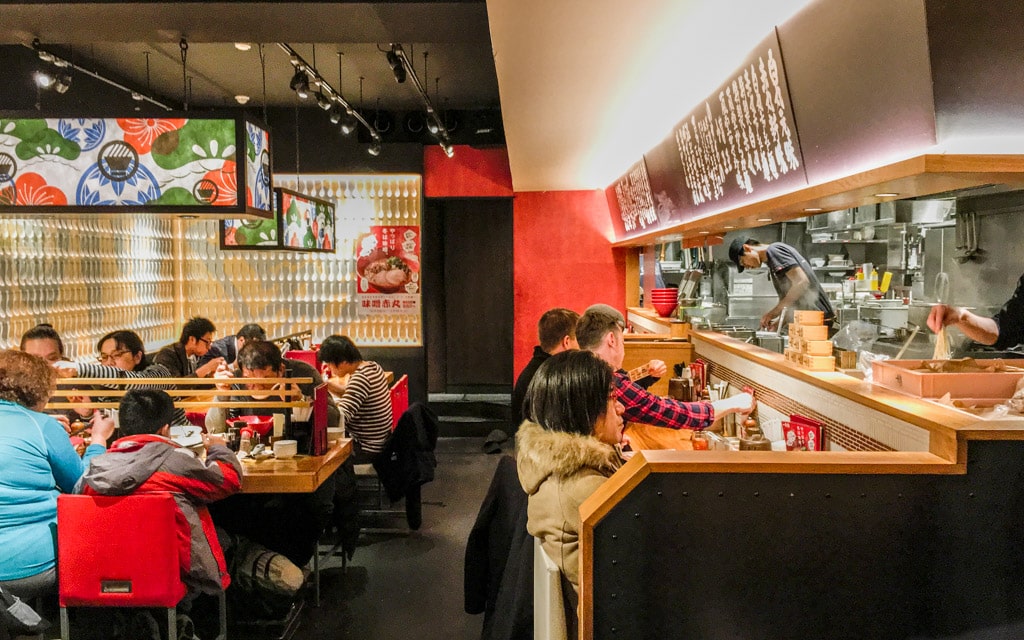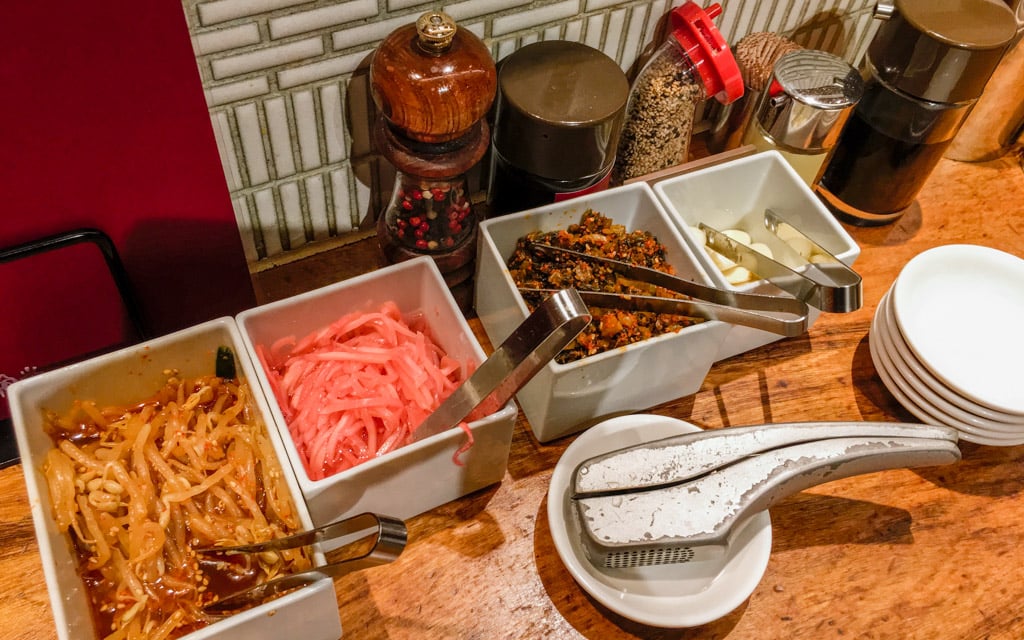
It was my last night in Tokyo, and I was looking for a place to eat near my Airbnb that wouldn’t break the bank. Unfortunately, I was staying in Ginza, one of the most expensive areas in Tokyo. Enter any restaurant in Ginza, and you can easily walk out with a 20,000 yen ($135) bill.
While wandering the area, I stumbled upon Ippudo Ginza, a chain of ramen restaurants with locations found all across Japan and the world. Locations outside Japan include Singapore, Hong Kong, Thailand, Paris, London, San Francisco, and New York City.
Ippudo, also known as Hakata Ippūdō, is famous for its tonkotsu ramen. For this ramen, pork bones are simmered for hours until you have a rich, flavorful broth. Lonely Planet even went as far as to call the chain “the most famous tonkotsu ramen shop in Japan.”
If you are looking for more information about Tokyo and Japan, I highly recommend you pick up a guidebook such as Lonely Planet Best of Tokyo 2020
Table of Contents
Interior

When I walked through the door into the restaurant, I was surprised to find a large, open dining room. The interior was bright both in color and in lighting.
While some of the floors and ceilings were black, there was an explosion of color everywhere, from the red and white chairs to the colorful hanging lights. A mosaic of countless ramen spoons and dried ramen noodles adorning the walls was a nice, unique touch.
While not upscale or fine dining, this differed from your typical ramen shop with only a few seats. It felt warm and welcoming. While casual, the décor was modern and sleek. It felt as if the interior was designed just for Ginza.

On one side of the dining room was a small counter next to an open-air kitchen. I sat here at the counter, which was the best seat in the house.
From my seat at the counter, I could watch the chefs dressed in black prepare bowls of ramen, yell orders to each other, and greet guests as they entered and exited.
Ippudo Ginza Menu

The menu at Ippudo Ginza offered four different types of ramen: Shiromaru Classic, Akamaru Modern, Ippudo Kasane, and Ippudo Karaka. A special version with extra pork, roasted seaweed, and a soft-boiled egg was also available, except for the Ippudo Kasane.
If this is your first visit to Ippudo, I recommend the Shiromaru Classic. This ramen is Ippudo’s original tonkotsu ramen, made with homemade Hakata-style noodles and broth simmered for 18 hours.
The Akamaru Modern is a modern take on tonkotsu ramen, made with miso paste and fragrant oil, along with homemade medium-thick noodles.
The Ippudo Kasane, introduced first at Ippudo’s main store in Hakata in 2001, features a mixture of tonkotsu and chicken broth. This option does not come in a special version.
Finally, there is the Ippudo Karaka, made with silky pork broth mixed with minced meat, chili bean paste, sweet soybean paste, and chili oil made with Japanese sansho peppers. For this ramen, you can choose from five different heat levels.
Additional Toppings

Like most ramen shops in Japan, you could add toppings to any bowl of ramen for an additional charge.
This included bean sprouts, scallions, kikurage mushrooms, roasted seaweed, seasoned quail eggs, home-made chili oil, soft-boiled egg, mentai (flavored cod roe), spicy meat miso, and wontons. You could also add extra pieces of chashu (sliced pork).
There was also an assortment of rice dishes, including Mentaiko Gohan, Hakata Chikara Meshi, Rice with Soft-Boiled Egg, and Steamed White Rice.
Side Dishes

Side dishes included Cucumber with Sesame, Chashu, Stir-Fried Sprouts, Pickled Tomato, Giblets with Ponzu Sauce, Boiled Dumplings, and Hakata Bite-Sized Dumplings.
Complementary Green Tea
I always enjoy when restaurants offer complementary green tea. I don’t know if I got a bad batch of tea or something, but the tea was rancid. It tasted like cough syrup. It was horrible.
Because I needed something else to drink, I decided to order a draft beer (500 yen or about $4.50). I found it interesting how the beer was served in a tall copper cup. The beer did its job by rinsing out the flavors of the tea.
Condiments

I can’t forget the assortment of condiments on the counter and at each table. There was everything you needed to add to your bowl of ramen or gyoza dipping sauce.
Condiments included bean sprouts, some pickled vegetables, soy sauce, sesame seeds, pepper, and garlic gloves ready to crush using the tool.
Hakata Bite-Sized Dumplings

First up were five pieces of the Hakata Bite-Sized Dumplings (220 yen or about $1.48 for five pieces, 420 yen or about $2.83 for ten pieces). I don’t know what it is about dumplings and me, but whenever I see them on a menu, even at a ramen place, I feel like I need to try them.
As the name implies, these bite-sized dumplings were, well, bite-sized. They were the perfect appetizer while I patiently waited for my bowl of ramen.
Each dumpling was pan-fried until hot and crispy on the outside yet moist inside. Inside was a mixture of juicy minced pork and minced vegetables.
While there wasn’t a lot of pork, what was in there was rich, salty, and delicious. The vegetables, including white and green onions, added a nice crunchy texture.
On the side was a spicy, smoky red chili paste that reminded me of Korean gochujang.
These dumplings, though simple and nothing extraordinary, just hit the spot. I was ready for the spicy ramen.
Special Ippudo Karaka

While the menu had many great options, I was in the mood for something spicy on a cold winter night in Tokyo. I decided on the Special Ippudo Karaka Ramen (1,120 yen or about $7.55).
This ramen featured silken pork broth and spicy minced meat miso seasoned with chili bean paste, sweet soybean paste, and chili oil. Scallions, roasted seaweed, and a soft-boiled egg topped the bowl.
For my preferred level of spiciness, I went for 8 spices. This selection was in the middle of the five options. I was hoping my selection would be spicy without overpowering the broth. Honestly, I had no idea what to expect or what spices would be in the ramen.
The broth looked beautiful, almost fiery. It was orange and red, with specks of oil floating around. I knew it had to be spicy. Since it was pork-based, I was expecting it to be heavy and thick. The broth was lighter than I expected.
So, was it spicy? Yes and no. For me, the broth and chili left the perfect slow burn in my mouth that intensified as I ate more. It was perfect.
Others might find it too spicy. Some sansho peppers or Sichuan peppers were mixed in, and they made my mouth tingle. It reminded me of the spicy ramen at Karashibi Miso Ramen Kikanbo.
I expected the silken pork broth to be rich, luscious, and flavorful. Maybe it was, but I couldn’t tell. While delicious, the chili bean paste, sweet soybean paste, and chili oil overpowered the broth’s flavors.
These additions made the broth salty, sweet, and spicy. It was umami, which was great, but without any pork flavors. Depending on your preferences, you might enjoy this or not. For me, I wanted more pork flavors.
Luckily, there were slices of pork chashu floating in the bowl. While thin, the salty slices of pork packed a lot of flavor. Each piece of pork was lean and tender with the perfect amount of melt-in-your-mouth fatty bits.
I wasn’t sure what to expect with the minced meat miso. Would it be salty? What kind of meat would it be? Unfortunately, much of the minced pork was lost in the broth when I reached it. The meat I tasted had a wonderful, slightly chewy texture with a rich, salty, smoky flavor.
Hidden in the broth was a generous portion of handmade noodles. The noodles were tender and springy as expected but were quite basic. I would have never guessed they were handmade if I didn’t know beforehand.
Slices of crunchy, salty roasted seaweed and a soft-boiled egg finished off this bowl of ramen. The roasted seaweed, or nori, started crispy but softened with a quick dunk in the broth. As the seaweed softened, it soaked up all the flavors of the broth.
My favorite component of this bowl of ramen was the soft-boiled egg. It was simple but cooked to perfection. A quick poke with my chopsticks and the egg exploded with a rich, creamy golden yolk that oozed into the broth.
While there was nothing precisely wrong with this bowl of ramen, it just wasn’t my favorite. This bowl was different from your usual Japanese ramen. It reminded me more of a spicy tomato soup.
While I had no issues with the heat, I felt as if the peppers and chili oil overpowered the flavors of the broth—and I love chili oil. Next time, I would order the Shiromaru Classic or head back to Ichiran.
Service
The service was fantastic and efficient, which is quite normal in Japan. They know what hospitality is all about.
All the workers seemed to have a smile on their faces, and they greeted each customer as they entered and left the restaurant. Even better, my food arrived quickly.
Conclusion
Ippudo Ginza was a beautiful place. The décor was casual yet modern and hip, inviting and warm on a cold night in Tokyo. The food, as all over Japan, was beautiful. The dumplings, while simple, were packed with a lot of flavor.
On the other hand, the Ippudo Karaka ramen was a bit of a letdown. I knew beforehand that Ippudo Ginza was known for its tonkotsu ramen, which is what I should have ordered.
While there was nothing wrong with the spicier ramen, it just wasn’t my cup of tea. The chili and pepper flavors were too bold, masking the broth’s flavors. If I ever return to Ginza, I will stop by and try the original Shiromaru Classic tonkotsu ramen.
Pros
- Flavorful dumplings
- Affordable food in an expensive area
- Assortment of condiments
- Beautiful, modern, and sleek décor
- Friendly service
Cons
- The broth in the Ippudo Karaka ramen overpowered by chili and peppers
- Often a wait, especially during lunch and dinner hours
Hours
Monday-Thursday: 11:00AM-2:00AM
Friday-Saturday: 11:00AM-3:00AM
Sunday: 11:00AM-1:00AM
Address
1F Central Bldg., 4 Chome-10-3 Ginza, Chuo, Tokyo, Japan
GPS Coordinates: 35.670628,139.767511
Map
Last Updated on March 14, 2024


Related Posts